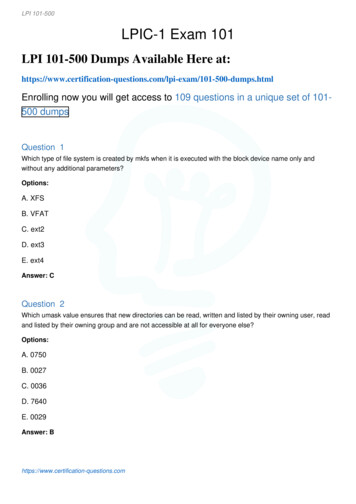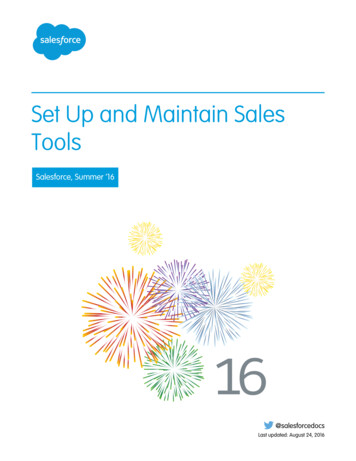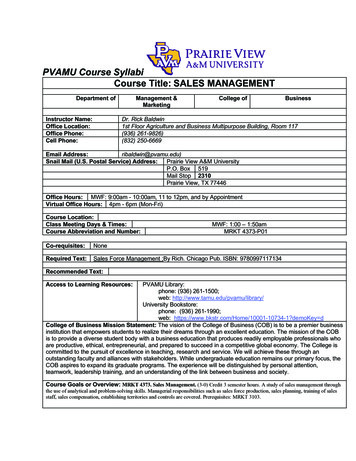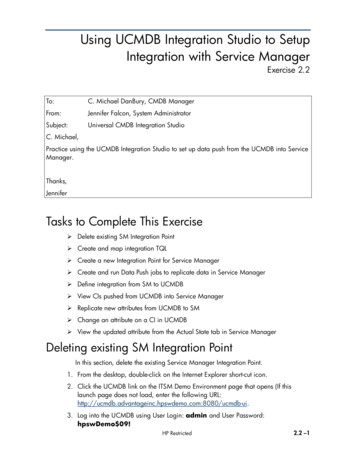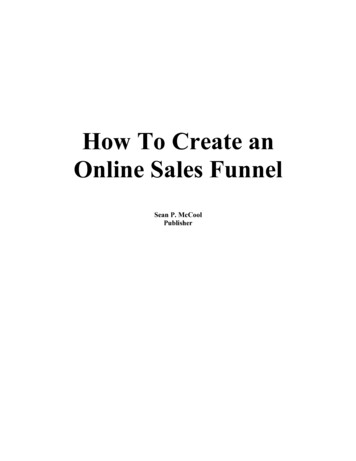
Transcription
Proceedings of the 2nd African International Conference on Industrial Engineering and Operations ManagementHarare, Zimbabwe, December 7-10, 2020Increasing Sales Online Through Integration OfDropshipping System And Social MediaFaiza Renaldi, Rival Muhamad Saepuloh, Agya Java MaulidinDepartment of Informatics, Universitas Jenderal Achmad Yani, Indonesiafaiza.renaldi@unjani.ac.id, rivalmuhamad17@student.unjani.ac.id ,java.maulidin@student.unjani.ac.idAbdul Talib BonDepartment of Production and Operations, University Tun Hussein Onn Malaysia, Malaysiatalibon@gmail.comAbstractDropshipping is an order fulfillment method that does not need a business to keep products in stock. Dropshipping ismostly done in the fashion industry, ready-to-eat food, handicrafts, and so on. Dropshipping makes it easy for beginnerentrepreneurs to start their business activities without having inventory costs first. The hallmark of drop shipping isrunning its activities online, so the logical consequence is that a well-computerized system is needed. Many previousstudies have discussed this dropshipping system. Still, most of them limit their case studies to specific products incertain areas and do not handle dropshipping business promotion technology. This research produces a mobile-baseddropshipping system that can be used freely and integrated with other social media platforms to expand the dropshipping brand name's promotional reach. An evaluation of the dropshipping system built showed that integration withother social media platforms increased the total sales figures of the dropshipping businesses studied, with an averageof nearly 20% of evaluations carried out over one month. The application of blockchain technology to this system isone of the next leading suggestions for improving existing transactions' security.KeywordDropshipping System, Integration, Social Media Marketing1. IntroductionDropshipping is a useful instrument used to process online orders for retailers (Li, Zhang, & Liu, 2019). Theagency can save holding, processing, and obsolescence costs for the retailer (Li, Zhang, & Liu, 2019). Although theymay have their warehouses and distribution centers, many online retailers also benefit from drop-shipping because theinstrument allows them to expand their product lines considerably without increasing inventory or warehouse costs(Li, Zhang, & Liu, 2019). With the development of e-commerce, financial constraints are the main problem for onlineretailers, and limited working capital often constrains online retailers' procurement decisions. As a new orderfulfillment method, dropshipping benefits the whole supply chain due to risk-pooling effects when a wholesalersupplies multiple retailers (Zeng, Gong, & Xu, 2019). The dropship system, which the perpetrator is often called adrop shipper, is an online buying and selling system where running an online business with this system does notrequire capital because running this system does not provide a stock of goods (Deddy Prihadi, 2018). Unlike resellers,drop shippers only sell information on these products without buying goods like a reseller. Dropshipping is mostlydone in the fashion industry, ready-to-eat food, crafts, books, office equipment, and so on. One of the most prominentadvantages of a drop ship is the lack of capital or even not spending money at all. Still, because the dropship does notbuy the goods first, the drop shipper does not control the goods, which causes dependence on suppliers. Overridingthe shortcomings of the dropship is a way to market products with minimal capital (Triyanto, 2017). Online marketingis an alternative to expand market share so that the sales process does not only occur in a specific place and time.Many large and small companies have used a website-based or mobile sales system. They are utilizing technology toexpand product marketing. IEOM Society International1974
Proceedings of the 2nd African International Conference on Industrial Engineering and Operations ManagementHarare, Zimbabwe, December 7-10, 2020There are many ways to do product marketing, one of which is social media marketing. Social media is onlinemedia, where users can easily participate, share, and create content without limited space. With the increasingpopularity of computer equipment for mobile communications, consumer online shopping behaviors have graduallytransited from computers to mobile terminals, such as smartphones (Li, Zhao, Xu, & Pu, 2020). Many social mediahave been installed in mobile applications, using social media users to interact with each other and share insightsbetween users worldwide (Deddy Prihadi, 2018). Some examples of social networks that are most popular with peopleinclude Facebook, Twitter, Line, and Youtube. One social media benefit is product promotion by planning, pricing,and advertising goods to existing and potential buyers. One social media in online shopping is Facebook social media(Ramadhani, Sukotjo, Juharsah, Sinarwaty, & Nur, 2020). Facebook has more than 1.7 billion daily active usersaccounting for 37% of global internet users. It is also a popular medium among marketers, with more than 86% ofmarketers in the US using Facebook for advertising in 2019 (Bhattacharyya & Bose, 2020). They are comfortableengaging via social media platforms. A majority of the business customers participating in an industry survey indicatedthat social media content had influenced their purchasing journey (Agnihotri, 2020)sIn recent years, social media users are increasing. Makes social media one of the most effective marketing mediafor introducing products besides content when making posts is one thing that must be considered, making persuasiveand consistent captions interspersed with promotions for the products to be sold (Mas'ud, 2017). Many previous studieshave discussed the dropship system to increase product sales, but most of them limit their case studies to certain areas.They do not deal with the promotional technology of the drop ship business. This study combines one of the Facebooksocial media platforms with the dropship system so that its promotion will be more widely affordable. This studyattempts to answer the gaps in previous research and create a mobile-based drop-ship system that functions as aproduct marketing medium and directly connected to Facebook.2. Research MethodThis study aims to build a dropshipping system that can expand marketing products' reach to increase salesfigures by integrating the system with Facebook's social media platforms. This research object is one of the small andmedium enterprise (SME) who conducts dropship business. This research is engaged in the shoe trading industry(Irmayanti, 2017). The system used before has not integrated into social media. Marketing is carried out only on theplatform itself. The promoted shoes are shoes provided by several suppliers who are willing to cooperate to receivetheir products. In terms of implementing the system, the supplier will provide data on the shoes that will be promotedby the drop shipper. Then the drop shipper will post on his online shop. At the same time, the drop shipper will alsopost on social media. The researcher will research for three months. The researcher will use the first two months tobuild the software. The following month, the researcher will carry out the implementation and evaluation of thesystem.To design and analyze a reliable system, we need a method that is often use. The data collection method is themost critical part of a study. In this study, the method used is the waterfall method (Ridho Rifaldi, 2018). The waterfallmethod also called linear sequential, is a sequential or sequential software development method, starting from theneeds requirement analysis, system design, system coding, testing, and maintenance stages (Taufik Hidayat, 2020).1) Software Requirements Analysis At this stage, it explains how the dropshipping business process works. Fromthe needs of making applications that combined into Functional (Atletiko, 2017). This research uses theinformants' direct interview method, namely dropship business actors, to collect the dropship system's needs.Interviews are making questions related to business processes in the dropship system.2) System Design Software design is converting previously acquired software requirements into a software systemdesign. (Taufik Hidayat, 2020). This study's system design is to identify all actors involved in the business processand define the functions that the system can perform.3) Construction, this stage changes the software design into program code, according to what has been designedpreviously. (Taufik Hidayat, 2020). In this study, building a mobile-based system on the Android platform. Thesystem design in the previous stage. The system implementation uses the Java programming language andMySQL database.4) Testing, the purpose of this stage is to ensure that the program output follows the system design (Taufik Hidayat,2020).5) Maintenance, sometimes the program has problems after being accepted by the user or not detected during testing.That is why there are maintenance stages. The goal is to fix if an error occurs when the user accepts the software(Taufik Hidayat, 2020). IEOM Society International1975
Proceedings of the 2nd African International Conference on Industrial Engineering and Operations ManagementHarare, Zimbabwe, December 7-10, 20202.1 Data Collection and AnalysisResearchers have carried out data to determine system requirements by observing and recording existing businessprocesses and data collection techniques by communicating directly with dropship business actors (Irawan, 2017).After collecting data and then performing data analysis, Researchers conducted data analysis after collecting all datasources. Researchers used data analysis to answer the problem formulation in the study (Ramadhan, 2017). The datais analyzed so that the researcher can formulate actors' data and functional requirements.2.1.1 Actor IdentificationActor identification, an actor is someone or something that interacts with the system. This system has threeactors, as in Table 1.NoActor1Customers2Dropshipper3SupplierTable 1. Actors in the SystemDescriptionCustomers can search for goods, order goods, and make payments according tointerests available on the system.A drop shipper is a person who enters goods data into the system. Then, the customercan see the available goodsA supplier is a person who can add goods, change, delete goods, and send goodsaccording to the drop shipper's request through the system.2.1.2 Identification of Functional RequirementsFunctional Requirements contain the system's processes or services, including how they react to specific inputsand how they behave in certain situations (Sutrisno, 2019). Here are the modules included in this system depicted inTable 2.Table 2. Functional RequirementsNo12FunctionManage ProductDataManage CategoryData3Manage User Data4Manage Sales DataDescriptionDrop shipper uses this function to manage product dataEach product will have a category. Drop shipper uses this function to create, modifyor remove types on the ProductThe administrator uses this function to manage system user data, customer data, dropshipper data, and supplier dataDrop shipper uses this function in transactions on systems that manage goodssales data, sales reports, and goods order data2.2 System DevelopmentIn this research, we build the system entirely on the android platform. The researcher used the android studio todevelop the application with the java programming language. The database used is MySQL as a web server. Thesystem's development is made based on the needs that have been determined by researchers at the previous stage.2.3 Integration SystemSystem integration is a system concept in which each system connected in the parent system is interconnectedwith each other according to needs. The system already built will use API technology as a medium to connect thesystem with Facebook. The study linked the drop shipper system to Facebook social media using the Graf API. TheGraf API is a fire made by Facebook that is used by developers. In addition to connecting the drop shipper system andFacebook, the system architecture is shown below in Figure 1. IEOM Society International1976
Proceedings of the 2nd African International Conference on Industrial Engineering and Operations ManagementHarare, Zimbabwe, December 7-10, 2020Figure 1. System Architecture3. Result And DiscussionsAfter building the system, this research carried out the implementation and monitoring phase of the system thathas been integrated with Facebook for 30 days. This system integration's technicality is that when a drop shippermakes a product addition or a change to the product, the system can simultaneously post about the work on theFacebook page.This study will use five shoe product data as a sample to be promoted to Facebook using an integrated system.Each product will have a category. That category serves to identify what product category the customer likes. Threetypes of posts created are as follows: New Product Posts. A class for posts with new product content or new variants on the product. Hot promo Posts. A category for products that receive discounts on a specific period. Recommended product, the class for the most sales in a given week or month, is subject to change.This system makes a daily post on the Facebook page for each product sampled, while the list of shoe productstested is as seen in Table 3.No12345Table 3. Product SampleProduct NameCategoryHeelsNew ProductFlat ShoesHot PromoHot PromoSneakersBootsHot PromoVansProduct RecommendedThis study does not describe the product sample specifically but will be represented by the shoe product type.There are five products in the table above, where one category of new development, three varieties of hot promo, andone class of product Recommended. Each product will be promoted daily through the Facebook page during ourresearch time. IEOM Society International1977
Proceedings of the 2nd African International Conference on Industrial Engineering and Operations ManagementHarare, Zimbabwe, December 7-10, 20203.1. Implementing The ResultThis system is implemented for 30 days by promoting each product through an integrated approach to Facebooksocial media every day. In other words, the system will post five times a day. Besides, this study considers threevariables: the number of posts, the number of clicks on these posts, and the number of transactions. Each variable willbe calculated every day during the system's implementation. The following Table 4 shows the result of implementingthe plan of week number one.NoNumber of PostsNumber of ClicksNumber of TransactionsTable 4. Week-11 23 45 55 58 10 12 91 43 055706582Total35651175111In the first week of system implementation, the number of posts done is 35 times, the number of clicks that occuris 65 times, and the successful transaction is 11 times, as shown in Table 5. The number of feeds remains the samebecause each product will only be posted one time a day. This week, The number of clicks almost double the numberof posts, and the number of transactions is still relatively low because the new system is implemented. We continueto the activities of week number 2, as shown in Table 5.NoNumber of PostsNumber of ClicksNumber of TransactionsTable 5. Week-21234555512 15 11 192511551736520275137Total3510721In the second week of system implementation, the number of posts made is 35 times, the number of clicks is 107times, and the successful transaction is 21 times. There is a considerable increase in the number of clicks, which isabout three times the number of posts made. For the number of transactions, there is a 2-fold increase from the previousweek. Furthermore, we proceed with activities in week three. The summary of the third week's actions can be seen inTable 6.NoNumber of PostsNumber of ClicksNumber of TransactionsTable 6. Week-31234555514 12 15 212725551616519475143Total3511124As we can see, the number of posts made is 35 times, the number of clicks is 111 times, and the successfultransaction is 24 times. The number of clicks this week is not very different from the previous week, and for thenumber of transactions, there is an increase, although not very large. Lastly, Table 7 showed the social mediamarketing activities in the fourth week of system implementation.NoNumber of PostsNumber of ClicksNumber of Transactions15196Table 7. Week-42345555516 18 24 205483652167519985171195135Total4516757The last week of system implementation is ten days. There are two days added because the total commission ofthe system is 30 days. The number of posts done is 45 times, the number of clicks that occur is 167 times, and thesuccessful transaction is 57 times. The number of clicks increased by ten from the previous three weeks. It is mainlydue to the addition of 2 days. The number of clicks increased 50% from a week earlier, and the number of transactionsincreased two times from the prior week. IEOM Society International1978
Proceedings of the 2nd African International Conference on Industrial Engineering and Operations ManagementHarare, Zimbabwe, December 7-10, 2020We have below depicted in Table 8 the summary of social media marketing results conducted in 30 days period. 1234WeekWeek 1Week 2Week 3Week 4TotalNumber of Posts35353545150Table 8. Result SalesNumber of Clicks65107111167450Number of Transactions11212457113After implementing the system for 30 days, the number of posts made is 150 times, the number of clicks thatoccur is 450 times, and the successful transaction is 113 times, can be seen from the sales result for 30 days, eachweek there is an increase in the number of clicks and the number of transactions.3.2 The EvaluationThe system's implementation for 30 days has carried out promotions through an integrated approach withFacebook social media. The number of posts made is 150 times for all products; the number of clicks for all positionsis 450 times. The total number of successful sales transactions was 113 transactions. The total increase in sales of shoeproducts every week can be seen in Table 9.No12345Table 9. Total TransactionsCategoryNumber of TransactionNew Product18Hot Promo19Hot Promo26Hot Promo14Recommended Product36Total113Product NameHeelsFlat ShoesSneakersBootsVansBased on the table above, the transactions that occurred were 113 times for all products, where each product hasits category, namely new products, hot promotions, and recommended products. In addition to hot promos, each classonly contains one work, then the transaction results for each category can be obtained, depicted in Figure 2.32%16%52%New ProductHot PromoProduct RecommendedFigure 2. Product Category IEOM Society International1979
Proceedings of the 2nd African International Conference on Industrial Engineering and Operations ManagementHarare, Zimbabwe, December 7-10, 2020We also summarized the 30-day sales data on the previous dropship system. Furthermore, we compared themwith the sales data on the dropship system that has been integrated on social media so that the sales increase will beseen in the system that has been built. The previous system had total sales of 90 transactions over the last 30 days.After 30 days of implementation, total sales for all categories were 113 transactions in an integrated system. The salesfigure on a system integrated with social media increased by 20% in 30 days, which means that this dropship systemcan increase sales figures by integrating with the Facebook social media. The visualization can be seen in Figure 3below.6050403020100Week-1Week-2Non Integrated SystemWeek-3Week-4Integrated SystemFigure 3. Comparison of Sales Integrated System with Social Media and Non-Integrated SystemWith the increasing number of sales transactions, sales turnover will also increase, were before using anintegrated system, sales turnover within 30 days reached Rp. 1.350,000, after implementing an integrated approach,the turnover obtained reached Rp. 1.620,000 in the same period. The reason for this increase is the expansion of themarketing area. The integrated system is not limited to the dropship system. Using a Facebook page as a promotionalmedium allows potential new customers from Facebook users.4. ConclusionThis study evaluates the system for 30 days. Before the integrated system, the sales turnover is Rp.13,500,000.After using the integrated system, social media, Facebook, the turnover achieved in the same period, Rp.16,200,000.From the results of the evaluation, there was an increase in sales turnover by 20%. The increase occurred because theplatform users themselves could only see product promotions in the previous system. After incorporating on theFacebook social media, the upgrades carried out can be seen by more people.Based on the research conducted, the drop shipper system integrated with social media can increase sales figuresby creating posts on dropship online stores. Those are directly connected to Facebook social media so that users onthe dropship system alone can see the latest posts. This research hopes that the integrated system can expand theproduct marketing area compared to the market planned to increase sales figures. The application of blockchaintechnology to this system is one of the next leading suggestions for improving existing transactions' security. IEOM Society International1980
Proceedings of the 2nd African International Conference on Industrial Engineering and Operations ManagementHarare, Zimbabwe, December 7-10, 2020ReferencesAgnihotri, R., Social media, customer engagement, and sales organizations: A research agenda, Industrial MarketingManagement, vol. 90, pp. 291-299, 2020.Atletiko, F. J., Development of Android Application for Courier Monitoring System, Procedia Computer Science,vol. 124, pp. 759-766, 2017.Bhattacharyya, S. & Bose, I., S-commerce: Influence of Facebook likes on purchases and recommendations on alinked e-commerce site, Decision Support Systems, vol. 138, pp. 113383, 2020.Deddy, P. & Susilawati, A. D., The Effect of E-Commerce Ability and Promotion on Social Media on MarketingPerformance, Benefit: Jurnal Manajemen dan Bisnis, vol. 3, pp. 15, 2018.Irawan, Y., E-Commerce Application for Small and Medium Enterprise (SME) Handicraft Marketing in Riau UsingDropshipping Techniques, Jurnal Ilmiah Core It, pp. 13-20, 2017.Irawanyanti, Renaldi, F. & Hadiana, I. A., Order Integration System for Dropshipping and Fulfillment of Goods inCimahi Micro, Small and Medium Enterprises, Using Web Service Technology, Prosiding SNATIF ke-4Tahun 2017, pp. 153-160, 2017.Li, G., Zhang, X., & Liu, M., E-tailer's procurement strategies for drop-shipping: Simultaneous vs. sequential approachto two manufacturers, Transportation Research Part E: Logistics and Transportation Review, vol. 130, pp.108-127, 2019.Li, X., Zhao, X. & Xu, W., Measuring ease of use of mobile applications in e-commerce retailing from the perspectiveof consumer online shopping behaviour patterns, Journal of Retailing and Consumer Services, vol. 55, pp.102093, 2020.Mas'ud, M., Utilization of Information System Technology to Increase Sales of Metal SME Products in Pasuruan City,Engagement : Jurnal Pengabdian Kepada Masyarakat, vol. 1, no.2, pp. 185-197, 2017.Ramadhan, F., Development of Interactive Mathematics Learning Media with Telegram Social Media Fire Bot at theSurabaya Pharmacy Academy, It-Edu, vol. 2, no.2, 2017.Ramadhani, N., Sukotjo, E., Juharsah, Sinarwaty, & Nur, N., The Effect of Service Quality on Customer Loyalty forFashion Products on Online Shopping through Facebook Social Media, Jurnal manajemen dankewirausahaan, vol. 12, no. 1, pp. 1-10, 2020.Sutrisno, Asyidiq, M. & Santoso, S., Designing an Online Advertising System for E-Commerce Applications (EGemanusa) Using the Fire Restful Method and the Laravel Framework, Jurnal Sains, Teknologi dan Industri,vol. 2, no.2, pp. 32-38, 2019.Hidayat, T., Yulindon & Hidayat, R., Website Designing as a Means to Meet Suppliers with Dropshippers, ULTIMAInfoSys, vol. 2, no. 11, pp. 21-26, 2020.Triyanto, W. A., Analysis and Design of Online Sales Information Systems to Increase Product Marketing forHandicraft MSMEs, Indonesian Journal on Networking and Security, vol. 6, no.3, pp. 63-67, 2017.Zeng, K., Gong, Y. & Xu, X., Supply chain choice with financial constraints on the internet: Dropshipping vs.traditional channel. Computers and Industrial Engineering, vol. 137, pp. 106093, 2019. IEOM Society International1981
Proceedings of the 2nd African International Conference on Industrial Engineering and Operations ManagementHarare, Zimbabwe, December 7-10, 2020BiographiesFaiza Renaldi is a researcher in the Department of Informatics, Faculty of Science and Informatics, UniversitasJenderal Achmad Yani Indonesia. He received his master of business informatics at Universiteit Utrecht, TheNetherlands, in 2006. His research interests are health informatics, information systems/information technologymanagement, e-government, agile project management, and IT entrepreneurship.Rival Muhamad Saepuloh is a research assistant at the department of informatics, Universitas Jenderal AchmadYani, Indonesia. His primary research interests are mobile app development.Agya Java Maulidin is a research assistant at the department of informatics, Universitas Jenderal Achmad Yani,Indonesia. His primary research interests are web services technologies, NoSQL technology, and mobile-basedapplication.Abdul Talib Bon is a professor of Production and Operations Management in the Faculty of Technology Managementand Business at the Universiti Tun Hussein Onn Malaysia since 1999. He has a Ph.D. in Computer Science, which heobtained from the Universite de La Rochelle, France, in 2008. His doctoral thesis was on the topic of Process QualityImprovement on Beltline Moulding Manufacturing. He studied Business Administration in the Universiti KebangsaanMalaysia, for which he was awarded the MBA in the year 1998. He has a bachelor's degree and a diploma inMechanical Engineering, which he obtained from the Universiti Teknologi Malaysia. He received his postgraduatecertificate in Mechatronics and Robotics from Carlisle, United Kingdom, in 1997. He had published more than 150International Proceedings and International Journals, and eight books. He is a member of MSORSM, IIF, IEOM, IIE,INFORMS, TAM, and MIM. IEOM Society International1982
Each product will have a category. Drop shipper uses this function to create, modify or remove types on the Product 3. ManageUser Data. The administrator uses this function to manage system user data, customer data, drop shipper data, and supplier data 4. ManageSales Data. Drop shipper uses this function in transactions on systems that manage goods
